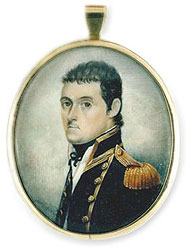Matthew Flinders' Journeys
Matthew Flinders (1774-1814) was the first man to circumnavigate Australia. His charts were so accurate that some are still in use to this day.
After sailing with the famous Captain Bligh on the Providence, Flinders' adventures brought him to Australia onboard the Reliance. In 1796 he explored the coastline around Sydney in a tiny open boat called Tom Thumb. He next proved that Tasmania was an island by finding and sailing through Bass Strait.
His most successful voyage came between 1801 and 1803 when he charted the coastline of Australia, completing and linking together other partial surveys to give us the first complete picture of our island nation.
Flinders recorded his voyage on the HMS Investigator. Read more about his circumnavigation in the journals he kept on board the ship:
Matthew Flinders - journal on HMS Investigator, Volume 1, 1801-1802
Matthew Flinders - journal on HMS Investigator, Volume 2, 1802-1803
Flinders was later shipwrecked on the Great Barrier Reef. Remarkably, he managed to navigate the ship's cutter across open sea back to Sydney, a distance of some 700 miles, and arranged for the rescue of the marooned crew on Wreck Reef.
On the return to England in 1803 Flinders stopped off in Mauritius for repairs. Away at sea and without news, he was not aware that England and France were now at war and he was arrested as a spy on arrival in this French colony. His incarceration would last almost 7 years.
Flinders lasting legacy is the name 'Australia' he gave to our country. He wrote to his brother:
"I call the whole island Australia, or Terra Australis."
Later that year he wrote to Sir Joseph Banks mentioning "my general chart of Australia." He continued to promote the name but could not convince Banks to endorse it. As a result, Flinders' book was published under the title A Voyage to Terra Australis. The day after his book was published in 1814, Matthew Flinders died, aged only 40, but already with an indelible place in Australian history.



